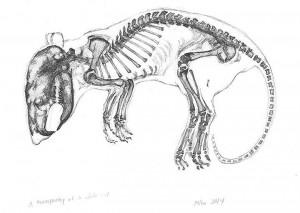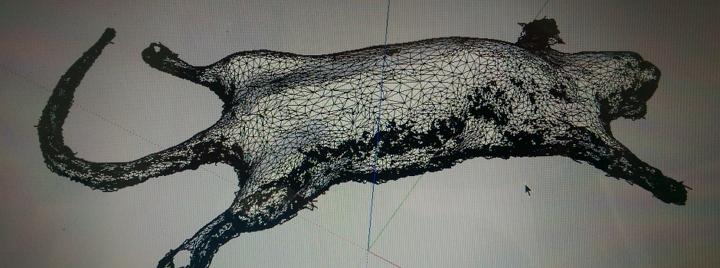 The Sprague Dawley Rat is the most commonly used laboratory animal in biomedical research, and the species has provided invaluable insight into a variety of scientific problems. But using the rats for research has raised a number of ethical and practical concerns throughout recent years.
The Sprague Dawley Rat is the most commonly used laboratory animal in biomedical research, and the species has provided invaluable insight into a variety of scientific problems. But using the rats for research has raised a number of ethical and practical concerns throughout recent years.
Now a multi-disciplinary team which includes a veteran necropsy technician, a classically-trained artist and a 3D print designer, NecropSynth, is proposing a way which might help solve a number of the concerns associated with the use of “lab rats” like the Sprague Dawley. The team calls the project prototype synthDawley, and they say the final result of their work will be “a macroscopically accurate model of an adult female rat with simulated vascular structure and insufflated with simulated bodily fluids.”
 For many years, future laboratory technicians and biologists have been trained with examinations of preserved animal subjects which they use for dissection. Those subjects have included fetal pigs, frogs, and lab rats. While it may seem a bit distasteful to some, the animal subjects have been critical in training technicians and scientists how to take histological samples and to perform what are called “diagnostic necropsies.”
For many years, future laboratory technicians and biologists have been trained with examinations of preserved animal subjects which they use for dissection. Those subjects have included fetal pigs, frogs, and lab rats. While it may seem a bit distasteful to some, the animal subjects have been critical in training technicians and scientists how to take histological samples and to perform what are called “diagnostic necropsies.”
But here’s the problem; the preservatives used to prepare the subject animals are carcinogenic, expensive and often require those in training to wear involved and uncomfortable personal protective equipment.
Aside from the practical concerns, there are also the moral and ethical concerns inherent in using living organisms and a desire to find more humane methods for training future generations.
“In essence we, as a society, have moved beyond the necessity to kill our most basic fellow inhabitants to educate our young,” says Bart Taylor of NecroSynth. “Since before the beginning of recorded history, we have been gathering information on animals for many purposes. Today we have them mapped out down to their most basic molecular building blocks. With the rise of 3D printing, we have the ability to synthesize from that immense pool of knowledge a model so complete that it can exceed what can be done with a standard, preserved organic sample.”

Taylor says they will be posting project notes, prototype anatomical components and sketches on their website as the work continues.
“It is our intention to change the face of anatomy education in the United States and the world,” Taylor says. “As with all things, this begins with the smallest of steps – the most minuscule of structures – but we have the will to see it through to the end.”
NecropSynth says that while they do exist, the current array of alternative synthetic models for dissection are unacceptable in detail and quality, and inaccurately portray organic structures, not to mention they are sometimes prohibitively expensive. That’s why the company plans to use 3D printing to build dissection models of laboratory animals with a process which makes “a seamless external shell with complex internal structures mimicking tissues and organs possible.”
By using the full panoply of of printing materials and object resolutions, NecropSynth says that they believe they can simulate all the differing “tissue” densities and even mimic the insufflation of fluids which will be very much like blood, bile and a number of other bodily fluids.
They say materials including PLA, ABS, and various other formulations will make it possible to build most – if not all – the distinctly different internal and external densities to simulate, bone, skin, and internal organs which will include “interstitial strata” of porous structures which will accurately mimic even connective tissue and serous spaces.
The final products will be created in stages from a series of prototype components meant to represent simulated aspects of anatomy, and the ultimate design goal is to provide scientists with an open source, 3D printable and anatomically accurate design for a range of commonly dissected animals.
Next up on the list, following the completion of the synthDawley, will be a frog specimen to replace the commonly used preserved versions now present classrooms. They add that the eventual goal of the project is to create a full production capability to provide fetal pigs, fish, cats and dogs in model form.
What are your thoughts on the NecropSynth project and their plan to 3D print all the necessary animal models to replace subjects from lab rats to frogs on dissection tables and in laboratory training facilities? Let us know in the NecropSynth forum thread on 3DPB.com.
Subscribe to Our Email Newsletter
Stay up-to-date on all the latest news from the 3D printing industry and receive information and offers from third party vendors.
You May Also Like
Precision at the Microscale: UK Researchers Advance Medical Devices with BMF’s 3D Printing Tech
University of Nottingham researchers are using Boston Micro Fabrication‘s (BMF) 3D printing technology to develop medical devices that improve compatibility with human tissue. Funded by a UK grant, this project...
3D Printing Webinar and Event Roundup: April 21, 2024
It’s another busy week of webinars and events, starting with Hannover Messe in Germany and continuing with Metalcasting Congress, Chinaplas, TechBlick’s Innovation Festival, and more. Stratasys continues its advanced training...
3D Printing Webinar and Event Roundup: March 17, 2024
It’s another busy week of webinars and events, including SALMED 2024 and AM Forum in Berlin. Stratasys continues its in-person training and is offering two webinars, ASTM is holding a...
3D Printed Micro Antenna is 15% Smaller and 6X Lighter
Horizon Microtechnologies has achieved success in creating a high-frequency D-Band horn antenna through micro 3D printing. However, this achievement did not rely solely on 3D printing; it involved a combination...






























